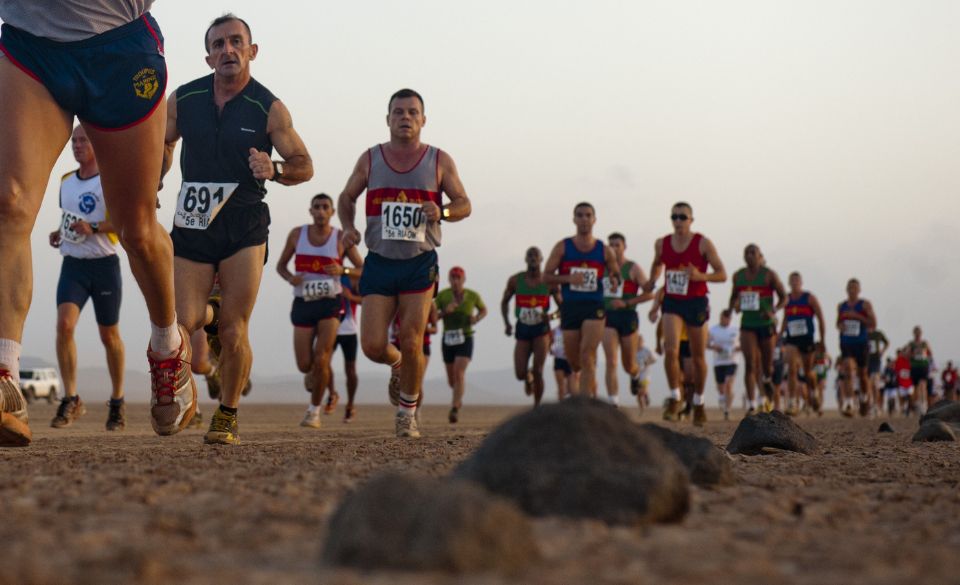
What Is A Runner’s Body? A Complete Guide
Page Contents
- Is Running Beneficial for You?
- Defining a Runner’s Body
- The Impact of Running on Your Body
- Does Running Sculpt Your Body?
- Frequently Asked Questions (FAQ)
- What body shape do you get from running?
- What is a typical runner’s body?
- How running changed my body?
- How is a runner’s body different from the gym body?
- Final Words – What Is A Runner’s Body?
Engaging in running not only reaps boundless rewards for your physical health, physique, and mental well-being but also unfolds a cascade of positive effects. This comprehensive guide aims to unravel the intricate details of how running influences your body, questioning whether it sculpts your physique and examining the distinctive traits of a runner’s body.
Is Running Beneficial for You?
While the merits of running are extensive, it’s imperative to acknowledge that excessive running can heighten injury risks and pose potential harm, especially for individuals with specific pre-existing medical conditions. For instance, severe osteoarthritis in the knees might necessitate a preference for low-impact exercises to mitigate joint pain.
Despite potential pitfalls, a wealth of evidence supports the myriad mental and physical health benefits associated with running.
Defining a Runner’s Body
The term “runner’s body” or “runner’s physique” often implies a particular physical form. However, it’s essential to emphasize that runners encompass diverse shapes, sizes, skin tones, gender identities, and body weights. Having a runner’s body is not contingent on adhering to a specific physique seen in elite marathon runners or sprinters.
It’s crucial to dispel the common misconception that a runner’s body is universally characterized by a long, lean, sinewy build. While many elite distance runners possess such characteristics, successful marathoners with a mesomorph or muscular build and competitive age group runners with varying body weights debunk this stereotype.
The diversity of running extends across various race distances, from short sprints to marathons, each manifesting in distinct physical attributes at the elite level.
Achieving a runner’s physique involves consistent training, acknowledging the influence of genetics on one’s inherent physique. Regardless of your starting point, improvement is attainable through running, a nutritious diet, and supplementary strength training workouts.
The Impact of Running on Your Body
Running bequeaths a plethora of benefits to your body, including:
Strengthening Heart and Lungs: Running, as a total-body, high-impact exercise, elevates heart and respiration rates, fostering cardiovascular health, increased stamina, and aerobic endurance.
Supporting Eye Health: Beyond the more apparent benefits, running may contribute to reducing the risk of cataracts and safeguarding vision by mitigating conditions like type 2 diabetes, high blood pressure, and obesity.
Reduction in Chronic Diseases: Running significantly decreases the risk of cardiovascular diseases, hypertension, type 2 diabetes, and certain cancers. Its efficacy in reducing blood pressure rivals anti-hypertensive medications.
Improving Joint and Spine Health: Contrary to misconceptions, running can enhance joint health and decrease the risk of arthritis. Research indicates that marathoners may exhibit healthier knees than sedentary counterparts. Moreover, running contributes to improved spine health, combating common causes of chronic back pain.
Strengthening Muscles: Running, especially with hill training and speed workouts, fortifies leg muscles, including quads, glutes, hamstrings, and calves, offering benefits beyond running to enhance various physical activities.
Strengthening Bones: The high-impact nature of running stimulates bone density, making it a potent exercise for those with the physical resilience to tolerate impact stress. Bones respond dynamically to stress, increasing mineralization and density.
Does Running Sculpt Your Body?
For those venturing into running, the burning question revolves around the transformation of legs before and after. Running undeniably tones your legs by simultaneously building muscle mass and reducing body fat percentage.
Muscle “tone” hinges largely on visible muscle definition and the firmness of muscles. The extent of muscle tone attained through running is influenced by body fat percentage, shaped not only by running and workout types but also by dietary habits.
In summary, a runner’s body embodies health, strength, and fitness, contingent upon comprehensive care. While running constitutes a pivotal component, maintaining a healthy and fit body necessitates consideration of other facets, including a nutritious diet.
Frequently Asked Questions (FAQ)
Below we delve into common queries, providing detailed and insightful answers about the characteristics, transformations, and unique attributes associated with a runner’s physique. Whether you’re curious about the impact of running on your body, the diversity among runners, or specific changes that may occur.
What body shape do you get from running?
Running can contribute to various body shapes, and the outcome depends on several factors, including genetics, training routine, diet, and overall lifestyle. However, certain trends are often associated with regular running:
Lean and Toned Physique: Long-distance runners, especially at the elite level, often exhibit a lean and toned physique. The repetitive motion of running helps burn calories and reduce body fat, leading to a more slender appearance.
Muscular Legs: Running, particularly over varied terrain and incorporating hill training, targets muscles in the legs, including the quadriceps, hamstrings, and calves. This can result in well-defined and toned leg muscles.
Balanced Body Composition: Regular running is known to promote a healthy balance of muscle mass and body fat. It engages various muscle groups, contributing to an overall toned appearance.
What is a typical runner’s body?
The idea of a “typical” runner’s body is a stereotype that doesn’t accurately represent the diversity within the running community. Runners come in various shapes, sizes, and body compositions. However, certain characteristics are often associated with elite or professional runners:
Lean Build: Many elite distance runners have a lean physique with low body fat. This helps improve running efficiency as excess weight can impede performance.
Defined Leg Muscles: A runner’s body, especially among marathoners and long-distance runners, often features well-defined leg muscles due to the repetitive and intensive use of the lower body during running.
Cardiovascular Fitness: A runner’s body tends to exhibit signs of cardiovascular fitness, such as a lower resting heart rate and increased lung capacity, which are adaptations to the demands of aerobic exercise.
It’s crucial to note that these characteristics are not exclusive to all runners, and individuals at various levels of running can have diverse body types.
How running changed my body?
Individual experiences with how running changes the body can vary, but some common transformations include:
Weight Loss: Running is an effective cardiovascular exercise that burns calories, aiding in weight loss. Regular running, combined with a balanced diet, can contribute to shedding excess body fat.
Improved Muscle Tone: Running engages various muscle groups, especially in the lower body. Over time, this can lead to improved muscle tone and definition, particularly in the legs and core.
Enhanced Cardiovascular Health: Running strengthens the heart and improves lung capacity, leading to better overall cardiovascular health. This can result in a lower resting heart rate and increased endurance.
Mental Health Benefits: While not a physical change, running is known for its positive impact on mental health, reducing stress and improving mood due to the release of endorphins during exercise.
How is a runner’s body different from the gym body?
Both a runner’s body and a gym body can be fit and healthy, but the methods and training emphasis may lead to some differences:
Cardiovascular vs. Strength Emphasis: A runner’s body is often adapted for cardiovascular endurance and may have a leaner appearance. In contrast, a gym body may emphasize strength training, resulting in a more muscular and bulkier physique.
Muscle Groups Targeted: Running primarily targets the lower body, including legs and core muscles. A gym body, depending on the workout routine, may have a more balanced development of upper and lower body muscles.
Body Fat Percentage: Runners may have a lower body fat percentage, given the calorie-burning nature of running. Gym-goers, depending on their goals, may focus on muscle building, which can affect body fat distribution.
Ultimately, these distinctions are generalizations, and individual variations exist based on training approaches and personal goals. Many individuals incorporate both running and gym workouts for a well-rounded approach to fitness.
Final Words – What Is A Runner’s Body?
In conclusion, engaging in running unfolds a myriad of benefits for physical health, physique, and mental well-being. This comprehensive guide has delved into the intricate details of how running influences the body, examining whether it sculpts one’s physique and unraveling the distinctive traits of a runner’s body.
The merits of running are vast, yet it is crucial to acknowledge the potential risks of excessive running, particularly for individuals with specific medical conditions. Despite these pitfalls, a wealth of evidence supports the multitude of mental and physical health benefits associated with running.
The term “runner’s body” often conjures a specific image, but it’s important to recognize the diversity within the running community. Runners come in various shapes, sizes, and body compositions. Achieving a runner’s physique involves consistent training, acknowledging the influence of genetics on one’s inherent physique.
Running bestows a plethora of benefits, from strengthening the heart and lungs to supporting eye health, reducing chronic diseases, improving joint and spine health, strengthening muscles, and fortifying bones. The burning question for many new runners revolves around the transformation of legs before and after. Running undeniably tones the legs by simultaneously building muscle mass and reducing body fat percentage.
In essence, a runner’s body epitomizes health, strength, and fitness, contingent upon comprehensive care. While running constitutes a pivotal component, maintaining a healthy and fit body necessitates consideration of other facets, including a nutritious diet. The distinctions between a runner’s body and a gym body highlight the varied approaches to fitness, each with its unique emphasis and benefits. Ultimately, individuals can find a well-rounded approach by incorporating both running and gym workouts into their fitness journey.


